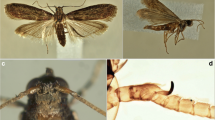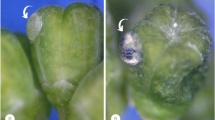Abstract
The second and third generations of Lobesia botrana can cause both yield losses and spreading of grape bunch rots. The aim of this study was to know to what degree these generations of L. botrana influence the rots at harvest time. The study was carried out in two grape-growing areas of northeastern Italy where the moth completes two and three generations per year, respectively. In the context of 12 insecticide trials, samplings were conducted in different plots to estimate the number of larval nests of the second and third generations and that of rotten berries at harvest time. The data sets (number of larval nests and rotten berries) from the different trials were submitted to regression analyses. Gray mold was the most important grape rot. The second generation, in the area where L. botrana has only two generations per year, and the third generation, in the area where the moth completes three generations per year, can favor gray mold on and around berries bored by larvae. In contrast, groups of rotten berries non-contiguous to larval nests did not appear to be influenced by moth activity. In the area where the moth completes three generations per year the larval nests of the second generation did not show a significant influence on bunch rots at harvest time.
Similar content being viewed by others
References
Battilani, P., Barbano, C., Marin, S., Sanchis, V., Kozakiewicz, Z., & Magan, N. (2006). Mapping of Aspergillus Section Nigri in southern Europe and Israel based on geostatistical analysis. International Journal of Food Microbiology, 111(S1), S72–S82.
Bellí, N., Mitchell, D., Marin, S., Alegre, I., Ramos, A. J., Naresh, M., et al. (2005). Ochratoxin A-producing fungi in Spanish wine grapes and their relationship with meteorological conditions. European Journal of Plant Pathology, 113, 223–239.
Bisiach, M., Minervini, G., & Zerbetto, F. (1987). Possible integrated control of grapevine sour-rot. In: R. Cavalloro (Ed.) Integrated pest control in viticulture (pp. 265–275). Rotterdam, the Netherlands: Balkema.
CAB (2003). Crop protection compendium: global module. Wallingford, UK: CABI Publishing.
Charmillot, P. J., Pasquier, D., & Degen, T. (2005). Climat et populations respectives des vers de la grappe eudémis et cochylis. Revue Suisse de Viticulture, Arboriculture, Horticulture, 37, 53–54.
Coscollá, R. (1997). La polilla del racimo de la vid (Lobesia botrana Den. y Schiff.). Valencia, Spain: Generalitat Valenciana. Conselleria de Agricoltura, Pesca y Alimentación.
Cozzi, G., Haidukowski, H., Perrone, G., Visconti, A., & Logrieco, A. (2009). Influence of Lobesia botrana field control on black aspergilli rot and ochratoxin A contamination in grapes. Journal of Food Protection, 72, 894–897.
Cozzi, G., Pascale, M., Perrone, G., Visconti, A., & Logrieco, A. (2006). Effect of Lobesia botrana damages on black aspergilli rot and ochratoxin A content in grapes. International Journal of Food Microbiology, 111(S1), S88–S92.
Dalla Montà, L., Marchesini, E., & Pavan, F. (2007). Relazione fra tignole della vite e attacchi di Botrytis cinerea. Informatore Fitopatologico, 57(4), 28–35.
Del Rio, G., Luciano, P., & Prota, R. (1987). Researches on grape-vine moths in Sardinia. In: R. Cavalloro (Ed.) Integrated pest control in viticulture (pp. 57–67). Rotterdam, the Netherlands: Balkema.
Fermaud, M., & Giboulot, A. (1992). Influence of Lobesia botrana larvae on field severity of Botrytis rot of grape berries. Plant Disease, 76, 404–409.
Fermaud, M., & Le Menn, R. (1989). Association of Botrytis cinerea with grape berry moth larvae. Phytopathology, 79, 651–656.
Fermaud, M., & Le Menn, R. (1992). Transmission of Botrytis cinerea to grapes by grape berry moth larvae. Phytopathology, 82, 1393–1398.
Fermaud, M., Valdés-Gómez, H., Calonnec, A., Roudet, J., & Gary, C. (2008). A multivariate analysis of combined effects of (micro)climate, vegetative and reproductive growth on grey mould incidence in grapevine. IOBC/WPRS Bulletin, 36, 91–94.
Gonzales, M. (2010). Lobesia botrana: polilla de la uva. Revista Enología, 7(2), 2–5.
Ioriatti, C., Anfora, G., Tasin, M., De Cristofaro, A., Witzgall, P., & Lucchi, A. (2011). Chemical ecology and management of Lobesia botrana (Lepidoptera: Tortricidae). Journal of Economic Entomology, 104, 1125–1137.
Marchesini, E., & Dalla Montà, L. (2004). Nel Veneto quattro generazioni di tignoletta della vite. L’Informatore Agrario, 60(4), 75–78.
Masante-Roca, I., Anton, S., Delbac, L., Dufour, M. C., & Gadenne, C. (2007). Attraction of grapevine moth to host and non-host plant parts in the wind tunnel: effects of plant phenology, sex, and mating status. Entomologia Experimentalis et Applicata, 122, 239–245.
Moleas, T. (1984). Biologia ed etologia della Lobesia botrana in Puglia. In: Atti del 3° Incontro sulla Difesa Integrata della Vite (pp. 91–97). Rome, Italy: Regione Lazio Edizioni.
Mondy, N., Pracros, P., Fermaud, M. & Corio-Costet, M. F. (1998). Olfactory and gustatory behaviour of Lobesia botrana in response to Botrytis cinerea. Entomologia Experimentalis et Applicata, 88, 1–7.
Mondy, N., & Corio-Costet, M. F. (2000). The response of the grape berry moth (Lobesia botrana) to a dietary phytopathogenic fungus (Botrytis cinerea): the significance of fungus sterols. Journal of Insect Physiology, 46, 1557–1564.
Mondy, N., & Corio-Costet, M. F. (2004). Feeding insects with a phytopathogenic fungus influences their diapause and population dynamics. Ecological Entomology, 29, 711–717.
Morando, A., Bosticardo, V., & Alberti, C. (1985). Lotta contro le tignole della vite con Bacillus thuringiensis Berliner e conseguenze sullo sviluppo di muffa grigia, marciume acido e acari. La Difesa delle Piante, 8, 277–283.
Moschos, T. (2005). Yield loss quantification and assessment of economic injury level for the anthophagous generation of the European grapevine moth Lobesia botrana Den. et Schiff. (Lepidoptera: Tortricidae). International Journal of Pest Management, 51, 81–89.
Moschos, T. (2006). Yield loss quantification and economic injury level estimation for the carpophagous generations of the European grapevine moth Lobesia botrana Den. et Schiff. (Lepidoptera: Tortricidae). International Journal of Pest Management, 52, 141–147.
Muckensturm, N., & Decoin, M. (2000). La pourriture grise de la vigne. Pourquoi la lutte échoue parfois, et comment la faire réussir. Phytoma, 525, 50–52.
Mundy, D. C. (2008). A review of the direct and indirect effects of nitrogen on botrytis bunch rot in wine grapes. New Zealand Plant Protection, 61, 306–310.
Pavan, F., Dalla Montà, L., & Turbian, E. (1989). Influence des divers anticryptogamiques sur les dégâts des vers de la grappe. In: R. Cavalloro (Ed.) Plant-protection problems and prospects of integrated control in viticulture (pp. 119–128). Brussels, Belgique: ECSC-EEC-EAEC.
Pavan, F., & Girolami, V. (1986). Lotta guidata alle tignole della vite su uve da vino nell'Italia nord-orientale. L’Informatore Agrario, 42(30), 35–41.
Pavan, F., Girolami, V., Cecchini, A., & Turbian, E. (1993). Evoluzione dei danni delle tignole della vite, Lobesia botrana (Den. e Schiff.) ed Eupoecilia ambiguella (Hb.), nell’Italia nord-orientale e lotta insetticida. Redia, 76, 417–431.
Pavan, F., Girolami, V., & Sacilotto, G. (1998). Second generation of grape berry moths, Lobesia botrana (Den. & Schiff.) (Lep., Tortricidae) and Eupoecilia ambiguella (Hb.) (Lep., Cochylidae): spatial and frequency distributions of larvae, weight loss and economic injury level. Journal of Applied Entomology, 122, 361–368.
Pavan, F., Sacilotto, G., & Girolami, V. (1987). Damage evolution, larval sampling and treatment period for grape moths. In: R. Cavalloro (Ed.) Integrated pest control in viticulture (pp. 39–49). Rotterdam, the Netherlands: Balkema.
Pavan, F., & Sbrissa, F. (1994). Dannosità delle tignole della vite, Lobesia botrana (Den. & Schiff.) ed Eupoecilia ambiguella (Hb.), su cultivar a maturazione tardiva nell’Italia nord-orientale. Frustula Entomologica, n.s., 17, 43–53.
Pavan, F., & Sbrissa, F. (1999). Soglie economiche di danno per la seconda generazione delle tignole della vite basate sulla perdita in peso. Frustula Entomologica, n.s., 20, 18–26.
Pavan, F., Zandigiacomo, P., & Dalla Montà, L. (2006). Influence of the grape-growing area on the phenology of Lobesia botrana second generation. Bulletin of Insectology, 59, 105–109.
R'Houma, A., Chérif, M., & Boubaker, A. (1998). Effect of nitrogen fertilization, green pruning and fungicide treatments on Botrytis bunch rot of grapes. Journal of Plant Pathology, 80, 115–124.
Roehrich, R. (1978). Recherches sur la nuisibilité de Eupoecilia ambiguella Hb. et Lobesia botrana Den. et Schiff. La Défense des Végétaux, 191, 106–124.
Roehrich, R., & Böller, E. (1991). Tortricids in vineyards. In: L. P. S. Van der Geest & H. H. Evenhuis (Eds.) Tortricid pests: their biology, natural enemies and control (pp. 507–514). Amsterdam, the Netherlands: Elsevier.
Rousseau, J., Blateyron, L., Drouillard, J. B., & Bonnet, N. (2005). Incidences directes et indirectes des tordeuses de la grappe sur la vinification et la qualité du vin. Phytoma, 587, 13–16.
Savopoulou-Sultani, M., & Tzanakakis, M. E. (1988). Development of Lobesia botrana (Lepidoptera: Tortricidae) on grapes and apples infected with the fungus Botrytis cinerea. Environmental Entomology, 17, 1–6.
Schruft, G., Wohlfarth, P., & Wegner, G. (1988). Untersuchungen zur Notwendigkeit der chemischen Bekämpfung des Einbindigen Traubenwicklers (Eupoecilia ambiguella Hbn.) im Hinblick auf ein Schadschwellen-Konzept. Die Wein-Wissenschaft, 43, 174–185.
Tasin, M., Betta, E., Carlin, S., Gasperi, F., Mattivi, F., & Pertot, I. (2011). Volatiles that encode host-plant quality in the grapevine moth. Phytochemistry, 72, 1999–2005.
Tasin, M., Knudsen, G. K., & Pertot, I. (2012). Smelling a diseased host: grapevine moth responses to healthy and fungus-infected grapes. Animal Behaviour, 83, 555–562.
Valdés-Gómez, H., Fermaud, M., Roudet, J., Calonnec, A., & Gary, C. (2008). Grey mould incidence is reduced on grapevines with lower vegetative and reproductive growth. Crop Protection, 27, 1174–1186.
Valli, G. (1980). Studio sulla correlazione tra tignole della vite e muffa grigia. In Atti del 2° Incontro sulla Difesa Integrata della Vite (pp. 21–25). Rome, Italy: Regione Lazio Edizioni.
Varela, L. G., Smith, R. J., Cooper, M. L., & Hoenisch, R. V. (2010). European grapevine moth, Lobesia botrana, in Napa Valley vineyards. Practical Winery & Vineyard Journal, March/April 2010.
Vartholomaiou, A. N., Navrozidis, E. I., Payne, C. C., & Salpiggidis, G. A. (2008). Agronomic techniques to control Lobesia botrana. Phytoparasitica, 36, 264–271.
Visconti, A., Perrone, G., Cozzi, G., & Solfrizzo, M. (2008). Managing ochratoxin a risk in the grape-wine food chain. Food Additives and Contaminants, 25, 193–302.
Zangheri, S., Dalla Montà, L., & Duso, C. (1987). Observations on the biology and control of grape moths in Venetia. In R. Cavalloro (Ed.), Integrated pest control in viticulture (pp. 27–37). Rotterdam, the Netherlands: Balkema.
Acknowledgments
We thank the grapevine growers for cooperation in carrying out this research and the Consorzio Tutela Vini DOC Friuli Isonzo (Cormons, Gorizia, Italy) for providing grapevine phenology and meteorological data.
Author information
Authors and Affiliations
Corresponding author
Rights and permissions
About this article
Cite this article
Pavan, F., Bigot, G., Cargnus, E. et al. Influence of the carpophagous generations of the European grapevine moth Lobesia botrana on grape bunch rots. Phytoparasitica 42, 61–69 (2014). https://doi.org/10.1007/s12600-013-0338-5
Received:
Accepted:
Published:
Issue Date:
DOI: https://doi.org/10.1007/s12600-013-0338-5




